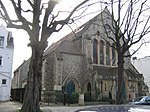Great Pagoda, Kew Gardens

The Great Pagoda at Kew Gardens in southwest London was built in 1761 by Sir William Chambers as a present for Princess Augusta, the founder of the gardens. Constructed of grey brick, the pagoda comprises 10 storeys, totalling 163 ft (50 m) in height, with 253 steps to the viewing gallery. Closed for repairs in 2006, the pagoda was reopened in 2018 following a major programme of restoration. It is a Grade I listed building.The ground floor roof is supported on wooden pillars. The storeys above this have arcaded balconies with Chinese Chippendale railings and curved roofs. The roofs are now of lead although they were originally covered in alternating bands of green and white tiles. The 80 restored dragons surmount each roof. Bridget Cherry, in her London 2: South volume of the Buildings of England series, describes the pagoda as "this supreme example of chinoiserie". A study of 2019, written after the restoration, ranked it as "the most important surviving chinoiserie building in Europe".
Excerpt from the Wikipedia article Great Pagoda, Kew Gardens (License: CC BY-SA 3.0, Authors, Images).Great Pagoda, Kew Gardens
Cedar Vista, London Kew (London Borough of Richmond upon Thames)
Geographical coordinates (GPS) Address External links Nearby Places Show on map
Geographical coordinates (GPS)
| Latitude | Longitude |
|---|---|
| N 51.4713 ° | E -0.2957 ° |
Address
Pagoda
Cedar Vista
TW9 2AZ London, Kew (London Borough of Richmond upon Thames)
England, United Kingdom
Open on Google Maps








